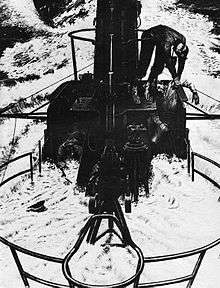Crash dive

A crash dive is a maneuver performed by a submarine to submerge as quickly as possible to avoid attack. Crash diving from the surface to avoid attack has been largely rendered obsolete with the advent of nuclear-powered submarines as they operate constantly submerged and are unlikely to be found on the surface. However, the crash dive is a standard maneuver used during surfacing when a collision is believed imminent.
A crash dive in a diesel-powered submarine requires careful orchestration of the crew. On German U-boats of World War II, a crash dive would begin with the Captain or senior lookouts giving the order "Alarm!", which led to a bridge officer activating the alarm bell. All crewmembers would then immediately stop what they were doing and proceed to their diving stations. Once the lookouts were below deck and the upper deck hatch was secured, the Captain or Chief Engineer would shout the order "Fluten" ("flood the tanks"). With the bow planes at a maximum down angle, the crew would then flood the forward ballast tanks of the submarine and, often, have all available crewmembers move as far forward in the boat as practical (a "trim party"). This extra weight forward gives the boat a bow-down angle so its momentum helps pull it below the surface. A few seconds later the rear ballast tanks are flooded in order to prevent the bow-down angle from becoming so extreme that the boat's stern rises out of the water. (An accident during the first patrol of U-505 caused just that when she crash dived to avoid an aircraft. Fortunately for the crew, the boat was not spotted during the moments before the crew could regain full control. The crewman who delayed in flooding the rear ballast tanks was subsequently given the nickname "Ostrich", a reference to the popular myth that the ostrich, when frightened, buries its head in the sand and thereby raises the position of its tail relative to its body.) The entire operation would generally be coordinated by the Chief Engineer.
Before the hatches and air induction vents fall below the surface they must be closed. Before that, the diesel engines must be stopped or they will suck the air out of the boat in a matter of seconds. On submarines with direct drive, the engines are disengaged from the propeller shafts and the electric propulsion motors/generators are switched to motor mode. The motors are run at high speed to maintain the forward momentum. Once all the hatches and induction vents are closed the diving planes are used like the control surfaces of an airplane to pull the boat below the surface and level out at the desired depth, typically between 70 and 90 metres (230 and 300 ft). In a World War II-era boat, the whole operation could take as little as about 30 seconds with a well-trained and experienced crew. In contrast, an Ohio-class ballistic-missile submarine may take as long as five minutes to reach periscope depth from the surface.
In extreme emergencies submarines have had to crash dive so quickly that lookouts were left on-deck. Such was the only survivor of U-68 when the four lookouts were left top-side as she crash dived among exploding aerial bombs. Commander Howard Gilmore earned the Medal of Honor posthumously during World War II by ordering a crash dive ("Take her down!") while wounded and unable to leave the bridge of USS Growler (SS-215).
See also
| Look up crash dive in Wiktionary, the free dictionary. |